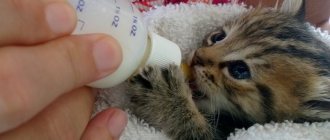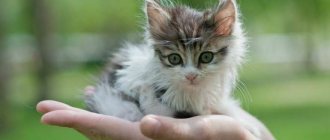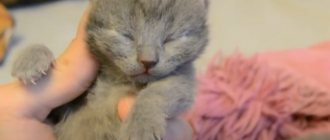If a kitten is left without a mother, its survival depends entirely on how well you organize its care. The ideal option is to find a surrogate cat mother for the baby who can feed the kitten (or kittens, if several were born). But this is not always possible. Therefore, if you are forced to cope on your own, the most important task should be to provide the kittens with food and warmth. Raising a kitten without a cat is quite possible, but you must understand that newborn kittens without a mother are very vulnerable, and you will need patience to care for them.
Preparing a place for kittens
An ordinary bed will not work for small kittens - you will have to make a special house for the little ones. For such a house you will need a small box.
Place absorbent pads at the bottom of the box - disposable diapers from a pet store or children's department will do. Change diapers when dirty. Place fabric on the sides to make the kittens more comfortable.
To keep the kittens from freezing, place a heating pad wrapped in cloth in the nest. If you don't have a heating pad, use a warm water bottle instead. Update the heating pad so that the kittens' house remains warm.
Place the house in a dark place, as it is too early for babies to strain their eyes with light. At the same time, leave the box open to allow air to flow in.
Make sure that there are no drafts or temperature changes near the kittens' house - the nest should be warm. Try to maintain a temperature of 30 degrees during the first month of the kittens' life.
Praise and Punishment
Remember that by bringing a kitten into your home, you have taken on responsibility. You have committed to put up with pranks, be patient, and be there if your pet gets sick. No child was brought up without punishment to a greater or lesser extent. You, as a “parent”, must be prepared to be tough.
Until the age of six months, the kitten is not punished, but ignored. If your child has done something wrong, be offended by him, turn away, change your tone. Give your pet the opportunity to independently recognize the wrongdoing. If the ward is deliberately naughty, you have to use the “whip”.
The best way to interrupt an unwanted action is noise . Buy a regular whistle, or just clap your hands. For example, if a kitten starts scratching the sofa, clap your hands and lightly slap it with a rolled-up newspaper. After such punishment, the baby will stop unwanted actions, and when he hears the clap, he will run away without waiting for the spank.
Features of care
Remember that newborn kittens are very fragile - wrap the kitten in a towel if you want to handle it.
Mother cat licks little kittens not only for the sake of hygiene: babies do not yet know how to go to the toilet on their own, and they will need a little help with this.
After each feeding, take a cloth and lightly rub the kitten's tummy. Also massage under the ponytail. Continue until your baby goes to the toilet. Feces appear in kittens from 3-4 days of life - until then only clear liquid will be released.
From 3-4 weeks, kittens will learn to defecate on their own.
Normally, kittens urinate after every meal, defecation occurs 3-4 times a day.
In addition, each kitten needs to be brushed daily. Wipe entire kittens with a soft, damp cloth or cotton pad.
To make kittens feel loved, babies need to be gently stroked with a finger or a cloth. The cloth creates the illusion that the kitten is being licked by the mother.
Take kittens to the vet regularly
Your care for kittens also includes periodically showing them to a doctor, who will conduct a professional examination and give all the necessary vaccinations.
It is advisable to take your babies to the vet once a month, even if they feel well. You should immediately contact a specialist if you notice the following features:
- diarrhea or prolonged absence of bowel movements in the kitten;
- sneezing, as well as discharge from the nose and eyes;
- lack of appetite and lethargy;
- weight loss;
- nausea and vomiting;
- presence of injuries and bleeding in the kitten;
- elevated temperature (above 39°C).
By the way, if you have difficulty with some aspects of caring for a newborn kitten, you can always contact veterinarians or a shelter where stray animals are constantly cared for. And if you do not plan to keep the kitten, perhaps through a shelter you will be able to find new owners for your ward.
Healthy and beautiful kittens to you!
What to feed newborn kittens
Forget about the idea of feeding kittens cow's or goat's milk - the composition of such milk does not meet the needs of kittens. These types of milk contain less lactose, protein and fat, which will lead to problems in the development of kittens.
To feed small kittens, buy special milk replacers for kittens - that’s what they are called in pet stores. Instructions for diluting the mixture are indicated on the packaging.
You will also need special nipples and feeding bottles - some manufacturers include them with formulas. If they are not in the mixture, buy them at a pet store.
It is important to hold the kitten correctly when feeding - a newborn kitten should lie on its back with its head slightly raised. Your baby will begin to suck on the pacifier instinctively, but be careful not to throw his head back and choke.
If the kitten is coughing, remove the pacifier, turn the kitten head down and let it catch its breath. Older kittens will approach the bottle on their own.
When the baby began to fall asleep during feeding or milk bubbles appeared from his mouth, he was full. Gently wipe his face and put him to bed.
Babies eat 2-4 milliliters of mixture at a time every 2-3 hours. It is important to maintain a feeding schedule both day and night until the kittens are 3 weeks old. From the fourth week of life, kittens are fed only during the day.
| Age | Number of feedings | Mixture volume |
| 1 Week | 7 | 2-5 ml |
| 2 weeks | 6 | 5-10 ml |
| 3 weeks | 5 | 10-15 ml |
| 4 weeks | 5 | 10-20 ml |
| 5 weeks | 4 | 10-25 ml |
| 6 weeks | 4 | 10-25 ml |
Feeding with formula milk can be continued for up to 6 weeks, however, from the month of life, kittens should be gradually introduced into the diet. However, food for adult cats is not suitable - choose types of food with special labeling “for kittens”.
You can determine whether kittens are eating well by their behavior: well-fed babies sleep peacefully, while hungry ones squeak and suck the finger extended to them.
When to start raising a kitten, how and what to teach it
The optimal age for parenting occurs immediately after the adaptation period. Be attentive to the kitten's habits if it is more than 3 months old. It is extremely important to correct your pet’s behavior gently, in a playful or rewarding way . Don’t even think about hitting a kitten for training purposes; this will make your pet more nervous and timid, but not at all obedient. Avoid stressful situations until the kitten is 6 months old:
- Frequent arrivals of guests, noisy parties or celebrations. Yes, it is a sacrifice, but it is made to strengthen your pet's psyche.
- Walking on a leash is of no use to the baby; he needs to fully explore the home, every cabinet and every shelf. In addition, a pet that has not received vaccination should not come into contact with street animals, as this is fraught with viral diseases, sometimes fatal.
- Punishment - at this age, the kitten is very pliable and its behavior must be corrected exclusively with positive motivation.
Cats are very receptive to training up to a year , this period is quite enough to master basic skills. The first priority is litter box training . On the very first day, keep an eye on the baby, as soon as he starts to “fumble” in search of the toilet, transfer him to the tray. If you don't have time, quickly blot up the puddle with a paper napkin and place it in the tray. Even 2-month-old kittens have a keen sense of smell and rely on it when searching for a litter box.
Important! If you have multiple cats in your home, get extra litter boxes! Firstly, each pet should have its own toilet, and secondly, do not forget that some cats go to different litter boxes - big and small.
Try to take the kitten to the toilet 15–20 minutes after feeding and stay with the baby until he relieves himself. It is worth refraining from frequent cleaning of the tray, since fresh litter does not have a characteristic odor. Keep the trophy napkin (or replace it with a piece of cloth), praise your ward every time until the habit of going to the litter box is established.
Difficulties of parenting and special skills
There are individual nuances in the issue of raising cats, especially when it comes to purebred animals. Siamese and Abyssinian cats are considered to be among the most restive. Among the hybrids, Ocicats, Bengals and jungle cats require special attention to education. Pedigree characteristics in raising kittens are mainly aimed at suppressing aggression and the desire to dominate the owner.
Before buying a kitten, be sure to discuss the characteristics of the breed with the breeder, or better yet, involve several experienced owners. Assess all the risks, especially if there are children in your family. For example, Siamese are very jealous of younger family members; they protect and protect children even from their parents. The Persian cat is naturally affectionate, calm and would rather avoid contact with the child.
Aggression in any form must be stopped immediately. Remember that a confident cat does not need to show off her physical strength. If you notice your pet's anxiety, try to find out the reasons for the discomfort. Communicate more with your ward, provide him with toys, horizontal bars and other toys. Cats that are potentially prone to aggression need to spend their energy correctly; as soon as this issue is resolved, your pet will turn into a tired, but affectionate and purring lump.
Socialization and games
The first contacts between children and kittens should be strictly under the supervision of adults. A small child perceives a pet as a toy and is capable of unknowingly causing him severe pain. Children aged 4–5 years need to be explained the rules for handling a new family member.
If there are other pets in the house, do not let them near the kitten right away. At first it is better to keep animals at a distance. Experienced owners advise locking them in different rooms and then switching places so that they get used to each other's smells.
A kitten is the same as a child, which means it needs affection and games. Take care in advance about purchasing cat toys: mice, balls, wigglers. If they are missing, it doesn’t matter either: the favorite of cats of any age is still a homemade device in the form of a rustling candy wrapper tied to a thin thread.
Biting is not allowed!
When playing, don't let your baby bite or scratch your hands. In nature, mother cats even lightly bite their playful cubs so that they come to their senses and behave decently. The owner, of course, has no right to bite, but he must stop the child who has crossed the border with the word “no” and stop the game for a while.
In conclusion, I would like to repeat that at the age of one month, a kitten is not yet ready to move to a new home. And when there is an opportunity to leave him next to his mother longer, it would be a sin not to take advantage of it.
Making your own kitten formulas
You can prepare milk formulas for small kittens aged 2 weeks to a month yourself using simple recipes:
- Tailing's mixture is nutritious and will be especially useful for exhausted, weakened, and poorly gaining weight babies. To prepare the mixture, add 5 g of milk powder, cat vitamins (1 g), and glucose (4 g) to 25 g of homemade milk. All ingredients are thoroughly mixed until smooth, without lumps, and heated over low heat to +38°C. The finished mixture is cooled to room temperature and used to feed artificial kittens through a pacifier or pipette.
- Scott's formula is a complete nutrition for kittens that can even replace mother's milk. To prepare this recipe, you need to combine the ingredients in one container: cow's milk (50 g), yeast (3 g), milk powder (15 g), sugar (5 g), sunflower oil (1 g), whipped egg white (50 g) , egg yolk (1). The mixture is whipped until smooth and heated to +37°C with constant stirring. The finished composition is poured into a bottle and cooled to room temperature. The mixture can be stored in the refrigerator, but no more than 1 day.
First feeding
Starting from 3 weeks of age, kittens begin to be offered “adult” food. To avoid overloading the digestive tract, do this very carefully and gradually.
Unusual food is given little by little, starting with feeding once a day and increasing the number of complementary foods to 3 times a day over 7-10 days.
All food is given to babies in the form of warm puree.
Homemade food
You can start feeding small pets with natural protein products. The most suitable ones would be:
- Shaved veal. To obtain scraping, meat that has been frozen for 24-48 hours is scraped with a knife on a cutting board to form lamellar pieces. The initial size of the meat portion is comparable to the size of a pea.
- Baby meat puree in small jars.
- Liquid, well-cooked milk porridge (rice and oatmeal).
- Cream with a fat content of 9-10%.
- Fresh low-fat cottage cheese without additives.
Industrial rations
Special dry food and canned food are developed for small kittens in the 1st growth phase and ensure a safe transition from dairy food to adult food. They contain proteins, fats, vitamins and minerals that ensure the proper development of the kitten, but do not create a burden on the immature digestive system.
According to breeders, the leader in this area is Royal Canin Babycat 34.
Its small pieces have a delicate texture, quickly swell in water and turn into a nutritious paste.
Also watch the video on how to feed a newborn kitten without a cat:
Natural nutrition
Natural feeding implies a diet consisting of natural products. Contrary to popular belief, pets should not be fed from the owner's table; such feeding can lead to the development of diseases.
When choosing a natural diet, veterinarians advise consulting with them in order to correctly calculate the menu for your pet. Excess or deficiency of substances can lead to disruption of growth and development processes, and junk food provokes the formation of diseases.
Features of the natural diet of kittens
For a carnivorous predator, sufficient protein intake is important, so the basis of the diet is meat. Veterinarians recommend feeding chicken, turkey or beef, as these varieties contain the least amount of fat.
Weak meat broths are given to babies from the second week. Soft minced meat is gradually introduced, and from a month on you can feed your pet finely chopped fillet.
For proper osteosynthesis, that is, the development of the bone apparatus, as well as the formation of teeth, a sufficient amount of calcium, magnesium and other elements that are contained in dairy products is necessary. The kitten's diet includes fermented baked milk, cow's milk, and cottage cheese.
Vitamins are found in fresh vegetables and fruits. At an early age they are served as a puree. By one month, the kitten can eat finely chopped ingredients.
The source of phosphorus is fish. Preference is given to marine species. In this case, the product is boiled and cleaned of bones. It is more advisable to use fillet.
Advantages
Supporters of natural nutrition explain their choice by the fact that natural nutrition does not contain harmful compounds - preservatives, additives, dyes, flavor enhancers. In addition, a wide variety of foods has a beneficial effect on your pet's health. With a properly designed menu, natural feeding ensures a complete supply of all necessary nutrients.
Flaws
Feeding your pet natural food can lead to poisoning if a prohibited product gets into the diet. In addition, independently compiling a menu may not take into account the individual needs of the baby and lead to a deficiency of vitamins and minerals or, conversely, their excess.
Important points related to feeding
In addition to the daily amount of formula or the frequency of feedings, there are several more nuances of feeding kittens without a cat.
During the first 14 days, attention is paid to the weight of the animal. Veterinarians recommend weighing your pet every day. A kitchen scale is suitable for this. Remember to wipe them with a damp cloth or sponge before and after weighing.
Keep a diary to track your weight gain or loss. If there are sudden changes or a rapid decrease, contact your veterinarian.
The temperature of the mixture you feed the kitten is also important. Adhere to the following standards:
- The first 7 days of life – 38°C.
- From 8 to 14 days of life – 30°C.
- From 15 to 21 days of life – 28°C.
- From 22 to 30 days of life – 24°C.
Make sure your kitten is always warm. Its digestion is to some extent dependent on body temperature. If your baby is cold, food is digested more slowly. In the case of the mixture, this leads to its fermentation, which causes digestive problems.
Your psychological attitude is also important. Stay calm and be patient. Your anxiety will be passed on to your pet. And it is difficult to feed a kitten that is anxious and trying to slip out of your hands.
Some veterinarians recommend introducing vitamins into the diet of bottle-fed animals. They are produced in liquid form. Admission is acceptable from 2 weeks of age of the animal.
How to transition a kitten to solid food
A gradual transition to solid food begins when the pet is 4 weeks old. First, one feeding is replaced with food. Then its share is gradually increased.
To wean the kitten from the formula, he is offered wet food. If the pet does not show interest in it, add one or two tablespoons of the mixture to the food. This will give the food a familiar smell to the animal and make it more liquid and soft.
Make sure your pet always has food in his bowl. This will give him the opportunity to come up and try new food at any time. Which will make weaning from the formula faster.
Veterinarians recommend that the kitten be completely self-feeding by 7 weeks. At the same time, he must eat six times a day.
How to prepare a house for a kitten
When a kitten for the first time leaves his cage, his box - his only “home” that he previously knew, and begins to wander around the apartment where he will henceforth live, the owner should take precautions. It is necessary to remove everything that could be dangerous for the baby (small objects, any chemicals). Outdoor shoes should be kept in a closed closet (for a kitten that has not yet been vaccinated, any contact with the street is dangerous). If there are any places where the appearance of a kitten is undesirable (on the windowsill with indoor plants, under the sofa), they should be immediately made inaccessible by covering them with some objects. If a kitten is taken away from its mother for the first time and brought into an unfamiliar apartment, it will initially show anxiety and fear rather than curiosity. It is better to start by limiting the area of his movement, for example, to one room, keeping him in sight, talking to him, periodically picking him up, calming him down, and letting him get comfortable.
Train your kitten to use the litter box right away. The tray should be purchased large and roomy; it is better to use special fillers, a wide selection of which can be found in any pet store. The place for the tray is usually chosen in a secluded, quiet corner of the toilet or bathroom, sometimes in the kitchen. When teaching a kitten to do its business in a certain place designated by you, you need to be patient and follow simple rules: as soon as a puddle or pile appears where it is not supposed to be, you must immediately dip a piece of paper in it and transfer it to the tray. Then the kitten is transported there to absorb characteristic odors. The smell in the wrong place is destroyed by all sorts of means; to be on the safe side, you can even make this place with some object to make it even more inaccessible. After several such procedures, the kitten will understand what they want from him and will go to the litter box.
It is important to accustom the kitten to the fact that he is periodically picked up, combed, his eyes and ears are cleaned, and his claws are trimmed. Then it will be easier for the veterinarian to help him if necessary, since cats accustomed to these simple procedures usually calmly allow the veterinarian to conduct an examination.
Baby teeth begin to be replaced by permanent teeth at 3 – 3.5 months. During this period, kittens sometimes refuse to eat. By 5, 5 – 6 months, usually all the kitten’s teeth have already been replaced with permanent ones.
Kittens are given away only towards the end of lactation, that is, not earlier than 2 months.











